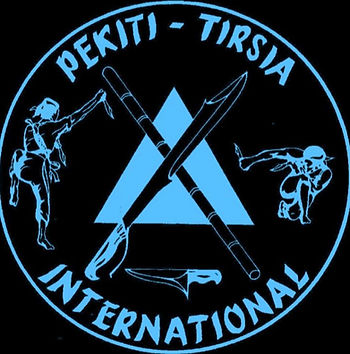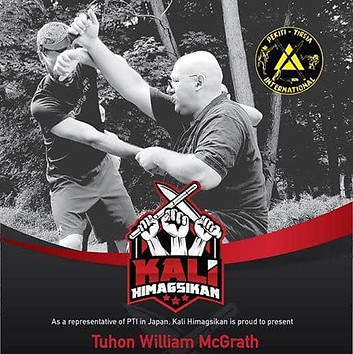Pekiti-Tirsia-Kali (PTK): The System
There are many different Filipino martial arts systems, more commonly known as by the terms eskrima or arniz. What sets PTK apart is the emphasis on footwork:
- To remove yourself from a weapon trajectory or position yourself to trap the weapon arm.
- To reach your opponent's flank opening more vulnerable targets.
- To compromise their balance and keep the opponent constantly reassessing the situation (disrupt their ooda loop).
- Efficient power generation
When Grand Tuhon Leo Gaje (the heir to system) started learning from his grandfather Conrado Tortal at six years old, he spent the first 3 years on just footwork. Footwork is a very integral framework for PTK.
PTK consists of 5 main weapon categories.
Solo- single stick, sword or spear
Doble- Double Stick or Double Sword
Espada y Daga – Sword and Dagger
Daga y Daga- Knife vs. Knife
Mano y Mano- Hand to Hand
Pekiti-Tirsia-International (PTI):
The method of instruction


Tuhon Bill Mcgrath started training with GT Leo Gaje in 1975 at 14 and was promoted to the rank of Tuhon in 1994. Soon after, he started Pekiti-Tirsia-International with the primary goal of preserving Pekiti-Tirsia-Kali. One way of preserving the system was implementation of the PTI Blue Books.
These served as a security feature of the system, ensuring that a certified instructor thoroughly evaluated a practitioner's teaching ability and skill before they are credited with being able to teach a curricular block. The following are tenants of PTI's mission statement.
There are No Secret Techniques in PTI: This keeps instructors honest.
A Known Rank Structure: This keeps students honest.
Don’t Say “Thank You” With Rank: Ranks are never awarded for favors.
This is a Martial Art, Not a Religion: The instructor and art are there to serve the students needs,
not the other way around.
Yokosuka Base: Belt Sashes

On Yokosuka base 6 beginner & intermediate curriculum blocks are spread across 6 sash colors. This is primarily to afford more flexibility in lesson plans while still moving toward clear goals for developing effective technique. By the end of the sashes students will be learning advanced material. Some small parts are left out of kids or teens class for prudence.
The curricular modules are the following:
1. Kickboxing and Tempering: Slaps; elbows; punches; hacks; knees; kicks; stomps; eye jabs. These are the weapons on the body. Tempering hardens various areas on ones arms to protect nerves. A lot of fundamental footwork is also introduced here. The goal is to enter against an opponents attack and land 3 good hits before pushing off to escape or engage another threat. We train to discourage tunnel vision; don't get swarmed by his buddies or kicked in the head on the ground if it can be avoided.
2. Solo Baston 5 Attacks: This subsystem addresses the initial phase of stick/sword fighting. The basic striking angles in module 2 serve to protect while looking for an opportunity to enter against the opponent as well as potentially end the fight early by taking out the opponent's weapon hand (primary target), eyes (secondary target), or lead leg (tertiary target).
3. Doble Baston 12 Attacks: 12 double stick attack patterns and concepts. Matching angles of attacks is necessary at the beginning to become familiar with lines of attack but asymmetry is introduced as early as possible to better simulate application in fighting. Just like before, footwork and timing are key to your attack being most effective versus the opponents attack.
4. Solo Baston Abecendario: 12 sets of 12 strikes, these are your 144 "letters". Module 2 taught how to enter effectively to access more targets on the body. This module teaches how to hit those targets for max damage or control your opponent depending on range and orientation of your weapon.
After becoming familiar with set 1 focus is placed on seeing how 1 attack is able to defeat the other numbers in a set through footwork/timing/use of non-weapon hand.
5. Empty-hand VS Knife: Gross motor skills from jamming/passing the weapon arm in module 4 prepare you for Empty-hand VS Knife. Your footwork/both hands working in unison to remove your vitals from the weapons path and redirect the blade arm while striking buys you time to safely draw an equalizer, escape, or take control of the situation through aggressive strikes and locks (breaks). If you or others are not in imminent danger it is preferable to exit if/when possible.
6. 64 Attacks: 8 subsystems of solo baston that, if well trained would make one a highly capable weapon fighter. Each form breaks down into various drills and concepts to train in sparring. There's even empty-hand translations to much of 64 Attacks, ask your certified trainer!




